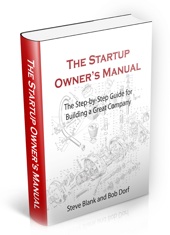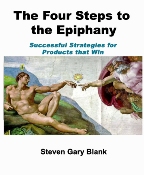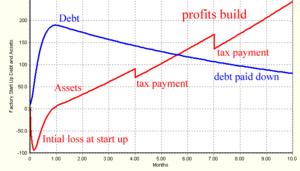Gunnar Holmstein, the Colorful CEO of
Clara comes up with interesting perspectives. He has a question about if startup
ecosystems should do what
Eric Ries talks about in his book The
Lean Startup. Rather than trying to build a "
Silicon Valley" clone in every city and country, should we be asking How can we build
Sustainable Entrepreneurial
Ecosystems the same way we build a company. The challenges are the same, and we face tremendous uncertainty in both situations. Can we build better Entrepreneurial Ecosystem by
asking the question how do we know it is
sustainable? how do we know what we are building is wanted by the market? What should be the metrics that we should measure, so that we can apply the Build - Measure - Learn iterative cycle to even Entrepreneurial Ecosystem building. I think we have a very interesting question to ask our guests and participants for the Conference in
Iceland in May. How do we Build a Sustainable Entrepreneurial Ecosystem. Have you signed up yet? if not you can @
http://signup.startupiceland.com.
Chris Schultz was fortunate to hear
Brad Feld talk about his 5 components of a sustainable startup ecosystem and he has written about it
here, and more recently Brad linked his post on
Startup communities to a talk given by
David Cohen in
San Diego and David has
7 things that need to be there for Startup ecosystems to flourish. Is it possible for us to measure these 5 or 7 things? Can we build-measure-learn these things? I certainly believe so. I am going to list them here and see how we can measure each:
- Long View – a 20 year timeline – stakeholders must be committed to the community for long term. Can this be measured? even if we could what would be the purpose of measuring this?
- Entrepreneurial leadership - It has to be lead by Entrepreneurs, cannot be led by governments, non-profits, big companies, VCs, lawyers, accountants, economic development, universities. All of those stakeholders need to be engaged, but entrepreneurs must drive it. This can be measured? basically who is running the show when it comes to Entrepreneurial ecosystem.
- Fresh Meat - Need new talent all the time, college graduates and people should move in and out. This is easy to measure, the number of new graduates coming out the universities and maybe a cross mash up between the Design/Creative group and the Technical/Engineering group. A Ratio of Creative/Analytical graduates
- Engaging Activities – engage the entrepreneurial community from top to bottom – startup to serial entrepreneurs – get all involved – you need a thing that engages all those people. You want really active engagement for a moderate period of time because its impossible to maintain a high level activity by someone on something that is not core focus. This can be measured as well, the example given is the TechStars program and other incubator programs in Boulder Colorado.
- Repeat – must have a rhythm with for a long time. Must have a beat that last through economic cycles. The only way to build a community is to move beyond boom and bust and build something over extended periods of time. This again is not relevant to measure, but it should be interesting to see continuity.
So what do you think? do we have the necessary ingredients to create an Entrepreneurial Ecosystem here in Iceland?

 There is a fundamental difference between a business model and business plan. A Business Model defines how you will make your product or service economically viable. A business plan describe how you are going to make your business model work. One does not always know how the plan is going to evolve, so building detailed plans although a great thought or intellectual exercise adds no real value because you are wasting time making assumption about the world out there and hope that your strategies or "plans" will address those assumptions and hypothesis. The truth could not be far from it. Most people confuse this with the product development road map and the classic example I get is people saying "hey, Steve Jobs did not go and interview his customers before he created the iPod, iPad, the Mac Air or any of the products that has come out of Apple..." to that I have only one answer, unfortunately there was only one Steve Jobs and how do we know that Steve did not do that? he had a keen eye for design and detail, he spend considerable amount of time in Silicon Valley being part of the information revolution and he had many fails to learn from. I try to remind those I am talking to that they need to spend 30 years in Silicon Valley, formed 2 or 3 multi-billion dollar companies, have the same network and experience of Steve Jobs before being able to compare themselves to what Steve Jobs did.
There is a simpler way, Steve Blank, has written books, taught classesand has done many things to showcase the Customer Development Methodology, which is nothing but a Business Model. If you approach problems with the Customer Development method, you can build a pretty good hypothesis and once you have an hypothesis, it can be validated and based on the results you can build a business. The trick is to get through that cycle as fast as you can and then execute based on the learning. It is never simple and straight forward you have change your hypothesis several times and build and re-build your business model that is why it is a startup.
There is a fundamental difference between a business model and business plan. A Business Model defines how you will make your product or service economically viable. A business plan describe how you are going to make your business model work. One does not always know how the plan is going to evolve, so building detailed plans although a great thought or intellectual exercise adds no real value because you are wasting time making assumption about the world out there and hope that your strategies or "plans" will address those assumptions and hypothesis. The truth could not be far from it. Most people confuse this with the product development road map and the classic example I get is people saying "hey, Steve Jobs did not go and interview his customers before he created the iPod, iPad, the Mac Air or any of the products that has come out of Apple..." to that I have only one answer, unfortunately there was only one Steve Jobs and how do we know that Steve did not do that? he had a keen eye for design and detail, he spend considerable amount of time in Silicon Valley being part of the information revolution and he had many fails to learn from. I try to remind those I am talking to that they need to spend 30 years in Silicon Valley, formed 2 or 3 multi-billion dollar companies, have the same network and experience of Steve Jobs before being able to compare themselves to what Steve Jobs did.
There is a simpler way, Steve Blank, has written books, taught classesand has done many things to showcase the Customer Development Methodology, which is nothing but a Business Model. If you approach problems with the Customer Development method, you can build a pretty good hypothesis and once you have an hypothesis, it can be validated and based on the results you can build a business. The trick is to get through that cycle as fast as you can and then execute based on the learning. It is never simple and straight forward you have change your hypothesis several times and build and re-build your business model that is why it is a startup.








